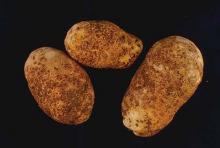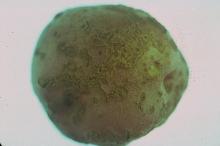By P. B. Hamm and C. M. Ocamb
Cause Streptomyces scabies (syn: Streptomyces scabiei), a filamentous bacterium that lives in soil and on diseased tubers. Other species, including Streptomyces acidiscabies and Streptomyces turgidiscabies can also be pathogenic. Streptomyces scabies can also infect carrots, parsnips, and red beets among other crops, and certain weeds. Neutral or alkaline soils favor common scab development. Russet varieties are generally less affected than smooth-skinned varieties and possibly can be grown where common scab has been severe. Soils containing high levels of organic matter which is not fully-decomposed, can have more severe disease.
Symptoms Corky lesions appear on the tuber's surface. Lesions may be small and superficial or consist of deep pits. This disease may be confused with powdery scab.
Cultural control
- Use certified seed potatoes.
- Do not plant in fields with a history of severe disease.
- Use tolerant varieties where possible. The Russet varieties, Norgold, Nooksack, Russet Burbank, and Targhee have good resistance. The variety Red Norland has moderate resistance.
- Lower the soil pH if above 7.0 or greater.
- High soil moisture for 1 week before emergence and 8 weeks after reduced common scab in 'Russet Burbank'. High moisture is defined as 80% or above of available moisture, measured at 9 inches in the soil.
- On calcareous soils, postplant sidedress applications of triple-superphosphate suppressed common scab, even when soil phosphate levels were greater than 20 ppm.
Biological control
- Bexfond at 7 to 14 fl oz/A. 4-hr reentry. O
Reference Strand, L. 2006. Integrated Pest Management for Potatoes in the Western United States, 2nd edition. UC Agriculture and Natural Resources Publication 3316. 167 pp.



